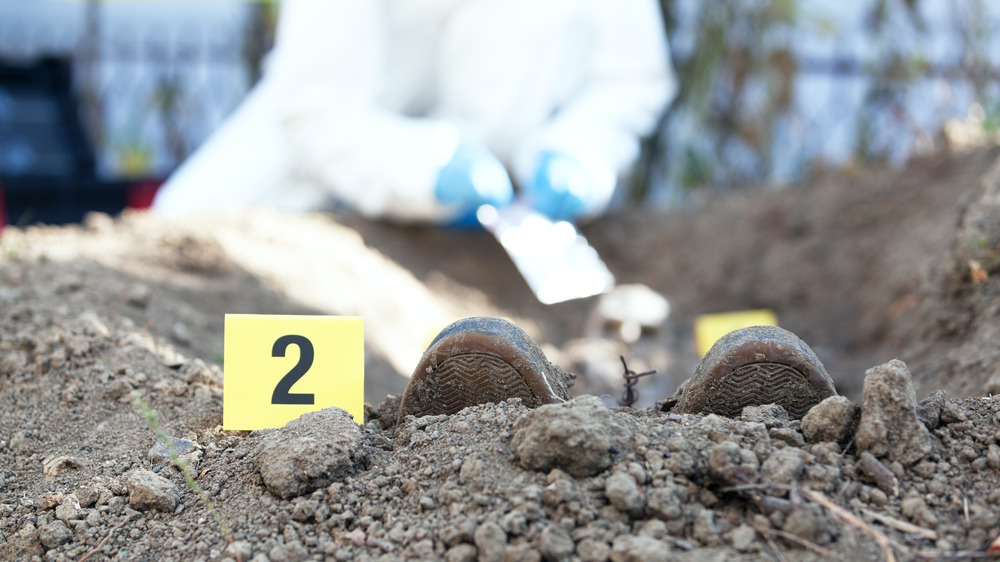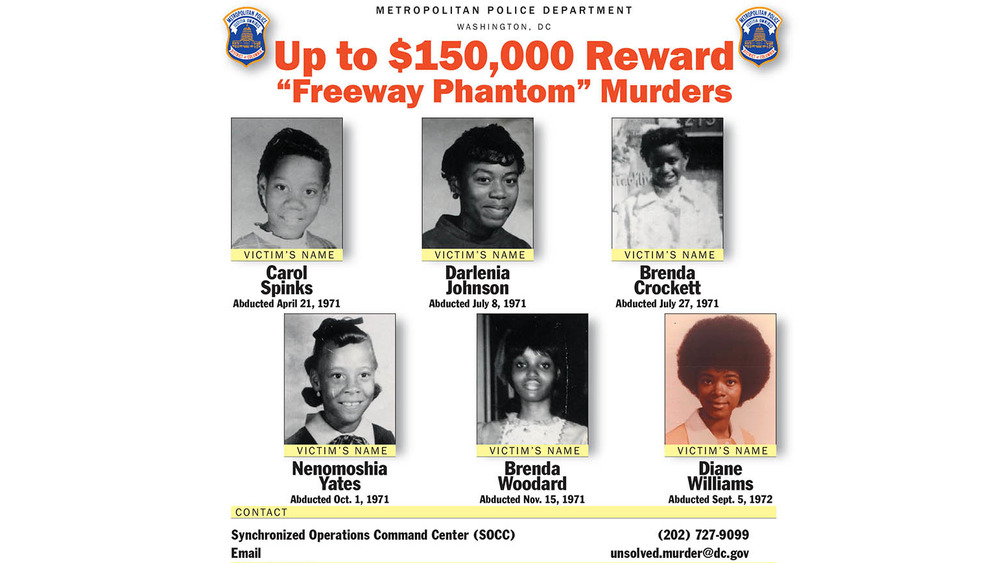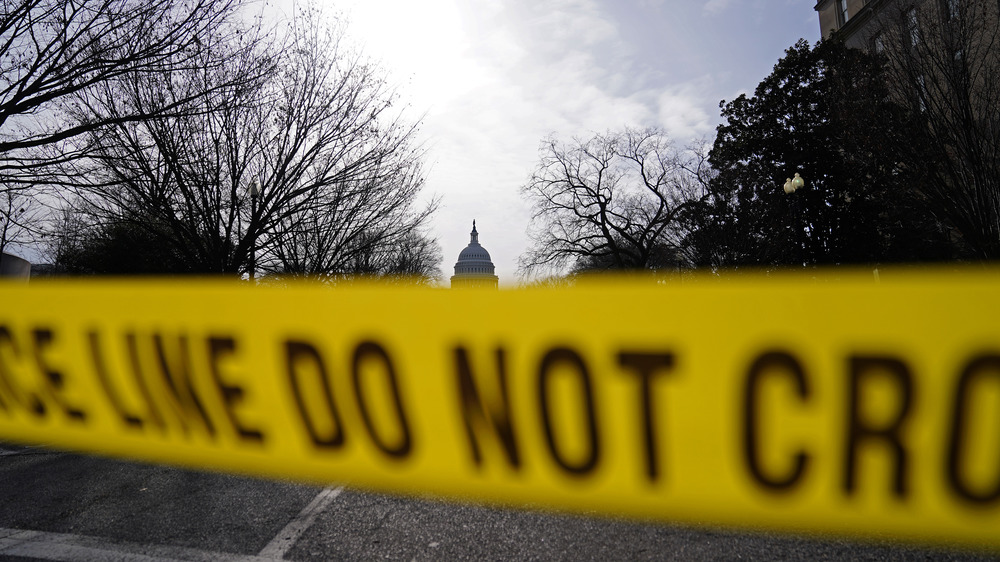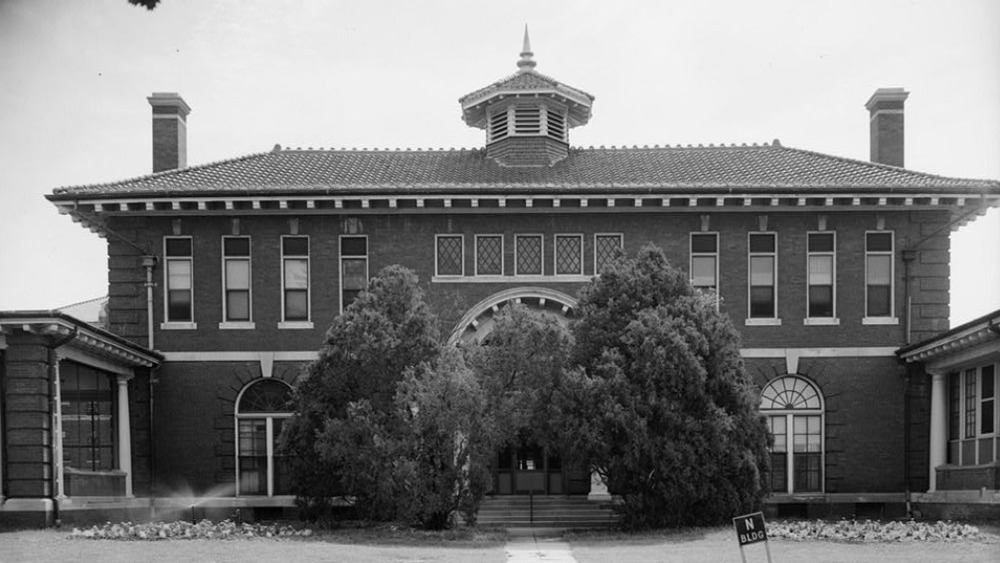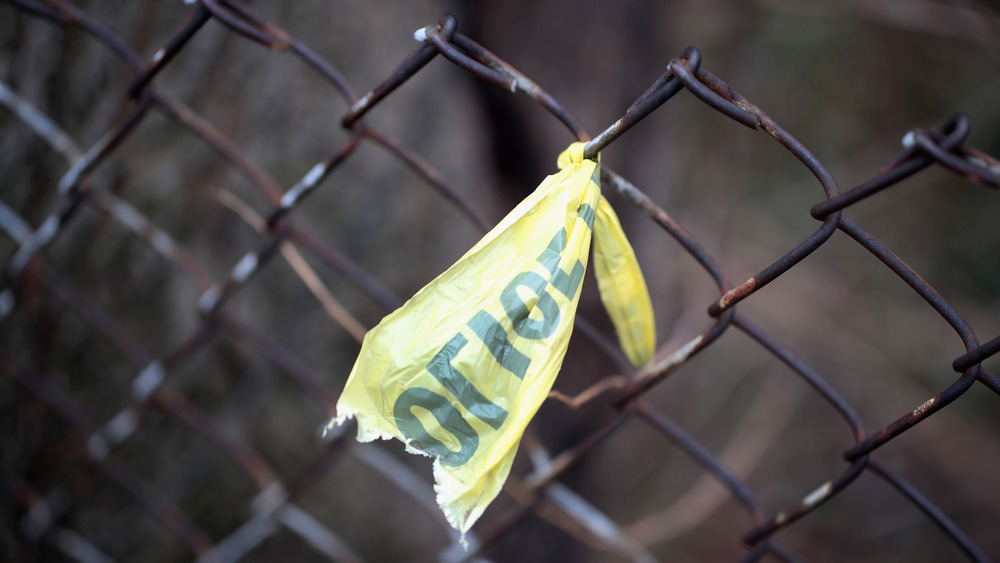The Untold Truth Of The Freeway Phantom
The Freeway Phantom has remained true to his moniker — a phantom. Despite the fact that he was Washington, D.C.'s first serial killer and claimed the lives of six young girls between April 1971 and October 1972, his identity remains a mystery.
One of the defining features of the Freeway Phantom is that he targeted young, African-American girls, per The Washington Post. His first victim, Carol Spinks, was just 13 years old when she left home one night to go to a 7-Eleven. She was found six days later on a grassy embankment next to the I-295 after being raped and strangled.
His next target was Darlenia Johnson, a 16-year-old girl with a summer job at Oxon Hill Recreation Center. One morning in July, she never arrived at work. She was later found just 15 feet from where Carol's body was dumped.
A week later, 10-year-old Brenda Crockett went missing after going out to see a movie. The next victim was Nenomoshia Yates, a 12-year-old who had gone to the supermarket to get groceries.
The fifth murder was Brenda Woodard, an 18-year-old who was taking the bus home after grabbing dinner with a friend. Last but not least was Diane Williams, a 17-year-old who was traveling home after spending time with her boyfriend.
All of the victims were raped, all were strangled, and five of the six also had their shoes removed. The exception was Brenda Woodard, who was more brutally murdered than the others, offering investigators their first clue about the killer.
Why Brenda Woodard's murder was different
Though Brenda Woodard's murder had several differences, the most vital to police was that the killer left a note on her body. He had even dictated the message for her to write out.
"This is tantamount to my insensititivity [sic] to people especially women. I will admit the others when you catch me if you can! Free-way Phantom!" the missive read.
Despite the disturbing message, former D.C. police detective Romaine Jenkins claimed that since Brenda's handwriting did not display excess duress, she likely knew her killer and did not realize the gravity of her situation at the time.
"There were no signs that she was nervous when she wrote the note," Jenkins explained in another article from The Washington Post. "You don't think calmly like that if someone has kidnapped and assaulted you."
However, police believe that once the situation turned dark, the note gave Brenda time to realize her fate and caused her to fight back against her captor. Though she was strangled, she was the only victim to be stabbed as well and also sported defense wounds, suggesting a bitter struggle. The killer also left her shoes on, unlike his other victims.
One mother might have seen the killer with her child
Jenkins also believes that 10-year-old Brenda Crockett's mother might have seen the killer in action. Brenda had called her home twice on the night she was abducted. The first call was to tell her sister that she had been kidnapped by a white man and had been driven to Virginia — a story police believe was fabricated to throw them off the scent.
Brenda then called a second time.
"Did my mother see me?" she asked her mother's boyfriend, who picked up.
"How could your mother see you if you're in Virginia?" he frantically answered, before demanding that she put her abductor on the phone. But that was not possible.
"Well, I'll see you," Brenda said in a whisper before the line went dead.
Jenkins believes that this second call was proof that the killer was nearby and thought he had been spotted by Brenda's mother, who had been out searching the neighborhood for her daughter.
"Why would you let her call home, not once, but twice?" Jenkins said. "He had to make sure that the mother didn't see her."
Clues into the Freeway Phantom's identity
One of the major clues into the Freeway Phantom's identity is that his geographical anchor point was St. Elizabeth's Hospital, a mental asylum in Washington, D.C. This suggests that the killer was familiar with the facility, and likely means that he was either a patient, a doctor, or a worker who knew the area well.
Another potential clue is that the Freeway Phantom appeared to keep trophies of his victims. Police have expressed their hope that someone might come across some of the tokens and alert investigators.
"He kept textbooks from one of the girls, curlers from another girl, shoelaces from another girl," noted Blaine Pardoe, who co-wrote a book on the murders. "Some family member may stumble across those things and say, why did he keep this junk?" he added, per CBS affiliate WUSA9.
Lastly, the Freeway Phantom stopped his crime spree in 1972. Investigators believe that suggests he either died, was incarcerated, or moved away from the area at the time.
Police have eyed several potential suspects
In the 1970s, police believed that a group known as the Green Vega Rapists were involved in the Freeway Phantom murders. One of the gang's members confessed to investigators that his colleague had committed the crimes. However, he stopped communicating with authorities after his allegation became public and he feared retribution from the gang. Police have since stated that the Green Vega Rapists were not the likely perpetrators and eyed a more likely suspect: Robert Askins.
Askins was a convicted kidnapper and rapist who had previously been charged three times with homicide. In addition, he had spent time as a patient at St. Elizabeth's Hospital. Last but not least, when authorities raided his home, he had saved an appellate court's opinion where the word "tantamount" was used, just like in the Freeway Phantom letter that was left on Brenda Woodard's body. Askins was also allegedly known to use the word often in conversation.
Unfortunately, there was no physical evidence to tie Askins to the crimes and he denied all connection to the Phantom Highway murders. He died in prison in April 2010.
Why the Freeway Phantom has been so hard to catch
There are several reasons why the Freeway Phantom has been so difficult to catch. He was probably charming, and would probably have seemed like an unlikely suspect to the community.
"Organized killers are likely to be above-average intelligent, attractive, married or living with a domestic partner, employed, educated, skilled, orderly, cunning and controlled. They have some degree of social grace, may even be charming, and often talk and seduce their victims into being captured," Psychology Today described.
He was also forensically savvy enough to wash his victims' bodies to destroy a lot of evidence, and the Freeway Phantom's DNA has not been recoverable. He disposed of the bodies in different states, which investigators believe was designed to keep different police departments from piecing the crimes together.
Though the FBI originally assigned around two dozen agents to the case, many were unfortunately pulled off the matter after the Watergate Scandal gripped the capital.
Lastly, the race of the victims also likely played a part.
"Those Black girls didn't mean anything to anybody — I'm talking about on the police department," claimed Tommy Musgrove, who joined the D.C. police in 1972 and later headed the homicide unit. "If those girls had been white, they would have put more manpower on it, there's no doubt about that," he added.
